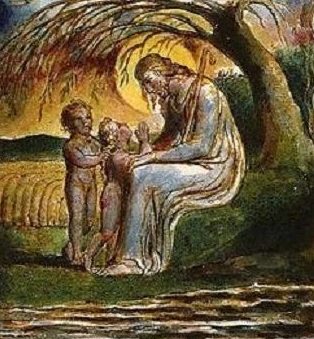William Blake, an influential poet, painter, and printmaker of the Romantic era, is renowned for his profound insights into the human condition and the interplay between the spiritual and material worlds. Among his many works, the poem “And Did Those Feet in Ancient Time” stands out as a powerful meditation on the relationship between England and its spiritual heritage. Often interpreted as a reflection on national identity, the poem evokes a yearning for a divine presence in the landscape of England, suggesting that the nation embodies a sacred mission.
In this blog, we will explore the key themes of the poem, focusing on national identity and heritage, spirituality, the contrast between idealism and reality, and the connection between nature and the sublime. Each theme reveals the depth of Blake’s vision and invites readers to consider their own relationship with spirituality and national identity.
National Identity and Heritage
Blake’s vision of a sacred England permeates “And Did Those Feet in Ancient Time.” He presents a landscape imbued with divine significance, suggesting that the nation has a unique spiritual heritage intricately linked to Christ. This portrayal invites readers to reflect on the idea that England is not merely a geographical entity but a sanctuary infused with sacredness.
The poem’s allusions to Jerusalem are particularly notable, as they symbolize an ideal state of being and a hopeful vision for the future. By referencing Jerusalem, Blake taps into a rich historical and cultural context, evoking notions of purity, redemption, and divine purpose. This connection not only emphasizes England’s potential for spiritual greatness but also positions it as a place where the divine can manifest in everyday life.
Furthermore, this theme elevates the English landscape to a realm of spiritual significance. Blake transforms familiar locations into sacred spaces, encouraging a deeper appreciation of the natural world and its connection to the divine. Through this lens, readers are invited to reconsider their understanding of national identity, seeing it as interwoven with spirituality and a collective heritage that transcends time. In doing so, Blake’s poem serves as a powerful reminder of the importance of recognizing and nurturing this sacred connection to one’s homeland.

Spirituality
In “And Did Those Feet in Ancient Time,” Blake intricately weaves together the secular and sacred, emphasizing that the divine can be found within the everyday landscape of England. This union serves as a powerful reminder that spirituality is not confined to religious rituals or institutions; rather, it can be experienced in the familiar surroundings of one’s homeland. Blake’s imagery invokes a sense of divine presence, suggesting that the natural world is a reflection of higher truths and spiritual ideals.
The imagery of Jesus walking on English soil is particularly poignant, as it evokes a profound sense of communion between the divine and the earthly realm. This vision positions Jesus not only as a distant religious figure but as a palpable presence that connects deeply with the English landscape. It prompts readers to consider the significance of their surroundings, urging them to recognize the divine in the world around them. By placing Jesus in this context, Blake encourages contemplation of how spirituality can manifest in everyday life, transforming ordinary experiences into opportunities for divine connection.
Ultimately, the poem invites readers to see the sacred in the mundane, fostering a deeper awareness of the spiritual dimensions of existence. By illustrating this union of the secular and sacred, Blake emphasizes the potential for redemption and renewal in everyday life, inspiring individuals to seek a deeper relationship with the divine.
Idealism vs. Reality
Blake’s exploration of idealism versus reality is a central theme in “And Did Those Feet in Ancient Time.” The poem juxtaposes his idealized vision of a holy England with the stark realities of his contemporary society, which was marked by industrialization and social upheaval. Blake expresses a longing for a past where the spiritual and material realms were in harmonious alignment, evoking a sense of nostalgia for an England that once embodied spiritual purity and moral integrity.
This sense of nostalgia resonates throughout the poem, as Blake laments the loss of a spiritual connection in the face of modernity. The contrast between the ideal and the real highlights a societal shift that has often prioritized materialism over spirituality. Blake’s poignant reflection serves as a critique of the industrialized society of his era, suggesting that the pursuit of progress has come at the expense of deeper spiritual values.
By examining this theme, readers are prompted to consider the consequences of modernity on their own spiritual lives. Blake’s work encourages a return to the values and ideals that once characterized a more spiritually enlightened time, urging individuals to seek a balance between the material and the divine. In doing so, he not only critiques his present but also invites a reimagining of a future where spirituality can once again flourish in the hearts and lives of individuals.
Nature and the Sublime
In “And Did Those Feet in Ancient Time,” Blake portrays the English landscape as a divine setting, elevating nature to a space where spiritual interactions occur. The imagery used throughout the poem transforms familiar locations into sacred spaces, suggesting that the beauty of the English countryside is not merely aesthetic but infused with spiritual significance. Blake’s vivid descriptions evoke a sense of wonder, inviting readers to appreciate the natural world as a reflection of the divine.
The spiritual significance of nature in the poem is profound. Blake suggests that the landscape itself can serve as a conduit for divine experience, urging individuals to recognize the inherent beauty and majesty of their surroundings. This portrayal aligns with the Romantic ideal that nature is a source of inspiration and enlightenment, offering a pathway to deeper truths about existence and spirituality. By emphasizing the connection between nature and the divine, Blake encourages readers to find solace and meaning in the world around them.
Moreover, this theme connects to the Romantic ideal of the sublime, where encounters with nature evoke feelings of awe and transcendence. The sublime reflects a recognition of something greater than oneself, and Blake’s work embodies this concept as he invites readers to contemplate the spiritual power of the English landscape. The interplay of nature and the sublime reinforces the notion that spirituality can be found in the ordinary, prompting individuals to engage with their environment on a deeper level and to seek the divine in their everyday lives.

Conclusion
In summary, “And Did Those Feet in Ancient Time” encapsulates several key themes: national identity and heritage, spirituality, the juxtaposition of idealism and reality, and the profound connection between nature and the sublime. Through these themes, Blake crafts a powerful meditation on faith, nationhood, and personal identity, encouraging readers to reflect on their own relationships with spirituality and their homeland.
The poem invites individuals to consider how their national identity is intertwined with a spiritual heritage and challenges them to recognize the divine within their everyday experiences. Blake’s work serves as a reminder of the importance of nurturing this connection to both the land and the transcendent, urging readers to seek out the sacred in the world around them. Ultimately, “And Did Those Feet in Ancient Time” stands as a timeless exploration of the quest for meaning and identity in a rapidly changing world, inspiring contemplation and a deeper appreciation for the interplay between the spiritual and the material.
Resources
- Blake, William.Songs of Innocence and of Experience. London: J.M. Dent & Sons, 1914.
- This text includes the poem “And Did Those Feet in Ancient Time” and provides valuable context for its themes.
- Eagleton, Terry.Literary Theory: An Introduction. Minneapolis: University of Minnesota Press, 1983.
- Offers insights into literary themes and their implications, enriching the analysis of Blake’s work.
- Hazlitt, William.The Spirit of the Age. London: 1825.
- Contains contemporary responses to Blake’s work and explores the themes present in his poetry.
- McGann, Jerome J.William Blake and the Age of Revolution. Princeton: Princeton University Press, 2008.
- Examines Blake’s poetry within the historical context of his time, particularly regarding themes of nationalism and spirituality.
- The Poetry Foundation.William Blake
- Provides a biography and analysis of Blake’s work, including insights into his thematic concerns and stylistic innovations.
FAQ
1. Who is William Blake, and why is he significant in literature?
William Blake was an English poet, painter, and printmaker of the Romantic era. He is significant for his unique artistic vision and his exploration of complex themes such as spirituality, national identity, and the relationship between the divine and the mundane. His works often challenge conventional norms and invite deeper contemplation of the human experience.
2. What is the main theme of “And Did Those Feet in Ancient Time”?
The poem explores several themes, including national identity and heritage, spirituality, the contrast between idealism and reality, and the connection between nature and the sublime. It reflects Blake’s vision of England as a sacred place intertwined with divine presence and calls for a deeper recognition of spirituality in everyday life.
3. How does Blake portray the relationship between nature and spirituality in the poem?
Blake portrays the English landscape as a divine setting, suggesting that nature itself is infused with spiritual significance. He encourages readers to find the sacred in the natural world, reinforcing the Romantic ideal that encounters with nature can evoke feelings of awe and transcendence.
4. What does the imagery of Jesus walking on English soil represent?
The imagery of Jesus walking on English soil symbolizes a deep spiritual communion between the divine and the English landscape. It invites readers to contemplate the presence of the divine in their surroundings and emphasizes that spirituality can be experienced outside traditional religious contexts.
5. How does the poem reflect Blake’s views on industrialization?
Blake contrasts his idealized vision of a holy England with the harsh realities of his industrialized society. He expresses nostalgia for a past where spiritual and material values were harmoniously aligned, critiquing the materialism that often accompanies progress and calling for a return to deeper spiritual values.
6. What is the Romantic ideal of the sublime, and how is it present in the poem?
The Romantic ideal of the sublime refers to the overwhelming beauty and grandeur of nature that evokes feelings of awe and transcendence. In Blake’s poem, this ideal is present through his portrayal of the English landscape as a setting for divine interaction, prompting readers to recognize the spiritual power of nature.
7. Where can I find more information about William Blake and his works?
You can find more information about William Blake through various resources, including his poetry collections like Songs of Innocence and of Experience, literary analyses such as Terry Eagleton’s Literary Theory: An Introduction, and online platforms like The Poetry Foundation, which offers biographies and thematic insights into his work.
